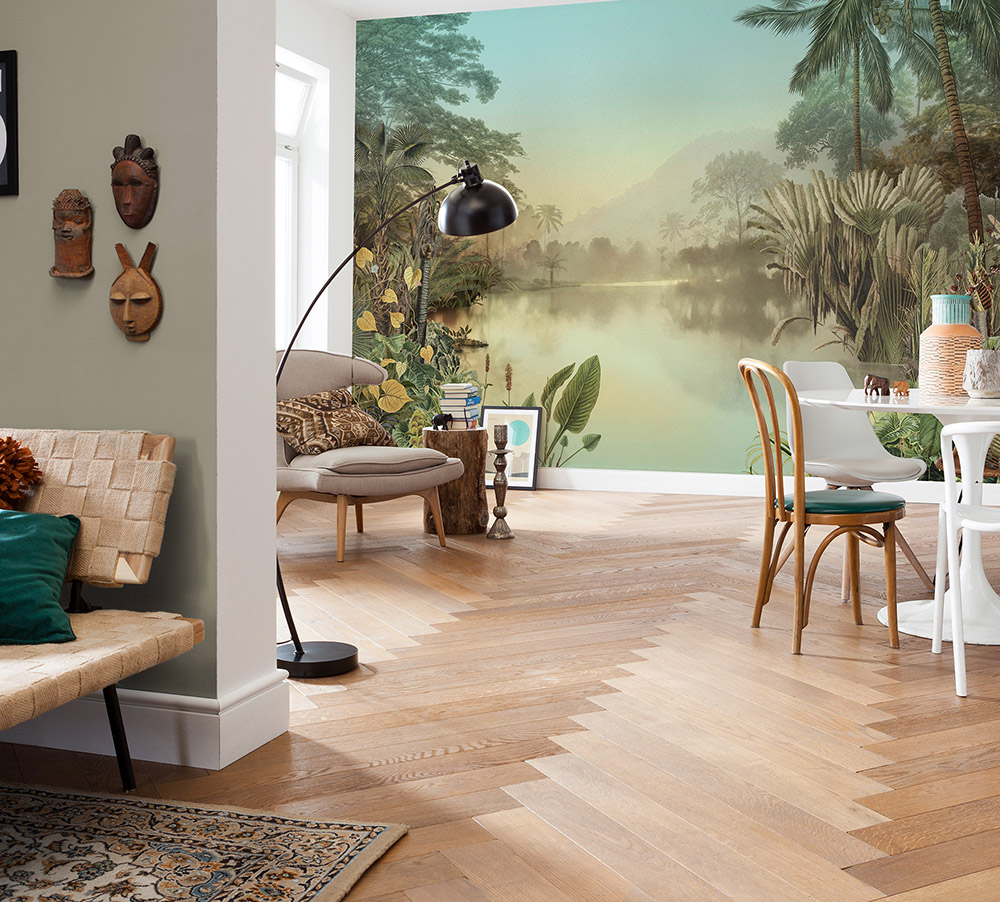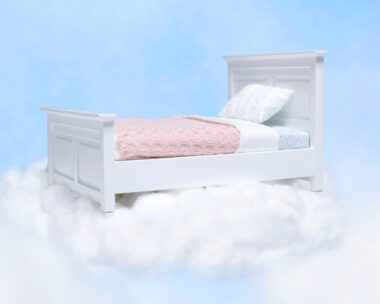While Resene’s exhaustive range of paint colours gives you unending possibilities when decorating, you can add a textural, patterned element that is only possible with the use of wallpaper. Wallpapers are now much easier to work with than they used to be and have become a popular option in virtually any room of the home as well as in offices and commercial settings. It’s not a case of either or; wallpaper can be used as a special feature in certain areas and paint choices can be complementary or echo colours used in the paper.
First, consider if you are using a wallpaper to kickstart a scheme or whether you need it to fit in with existing elements? What feel are you going for? Do you want to make the room feel expansive, do you want to add warmth, cosiness, drama or whimsy?
Papers with a dark cool-coloured background such as deep blue or charcoal can make a room feel larger, especially if they feature a small tonal pattern. Soft pastel colours will bring a peaceful aspect to a space, while warm colours and busy patterns can add character and vibrancy. Small patterns make a room look larger, while large patterns make a space feel smaller and more intimate. Stripes and vertical patterns make walls appear taller, whereas horizontal patterns make a wall appear longer. Layered patterns and trellis-like designs give flat walls more depth.

Botanicals, exotic and jungle themes are popular this year. Resene Wallpaper HX8-049 brings a sense of peace and calm to the room.
If you’re unsure about papering a whole wall, wallpaper is also good for smaller areas, like behind a glass splashback, on the front of a chest of drawers, at the back of shelves or on a chimney breast.
Wallpaper to the rescue
Wallpaper can help to overcome existing problems such as low light levels and less-than-perfect walls. The thickness of the paper and the visual effect of the pattern help cover the bad bits. In a hallway or dark room, choose a wallpaper that has a sheen or metallic aspect, so it will reflect light around the space. Steer away from heavily textured wallpapers in confined areas as these will appear darker and close in the space. Textured papers and Anaglyptas (paintable papers in your favourite Resene paint colour) are perfect, however, for covering imperfect walls. Heavily patterned wallpapers or those with a layered design like a floral over a mottled background, will distract your eye from an uneven wall.
Keeping it Kiwi
The work of William Mason, a Napier-born and London-trained textile designer, arguably New Zealand’s best, has been brought back to life by Resene and in fact, it’s where Resene’s love affair with wallpaper began. Mason lived in Wellington in the 1950s, teaching art and exhibiting paintings. He began producing hand-printed textiles, then wallpapers which were eagerly snapped up by homeowners renovating old villas and were also used in embassies worldwide. Resene bought Mason Prints in 1974, complete with the Marion Street building in Wellington which housed the wallpaper showroom and subsequently became the first Resene ColorShop. Resene continued to expand on the original designs with the current collection available hand-screenprinted using Resene paint. View or order the Mason Handcrafted Wallpaper collection at your local Resene ColorShop or find out more online at www.resene.com/mason.

The simplicity of the geometric design in Resene Wallpaper Collection HX8-053, along with the classic dark blue and gold colour scheme imparts a timeless elegance.
A history of wallpaper
Wallpaper originated in the 16th century when it was used to decorate the insides of cupboards and small rooms in merchant’s houses. Early papers featured stylised floral motifs and pictorial scenes copied from embroideries of the time. They were monochrome prints on small sheets of paper. In the mid-17th century these single sheets were joined together in long rolls which led to repeat patterns and the advent of block printing where the design was engraved onto wooden blocks which were then inked and pressed into the paper. In 1634 Jerome Lanier, a Huguenot refugee working in London, patented a method by which coloured wools could be applied to painted paper, and by the end of the 17th century flock wallpapers, as we know them, had appeared. They quickly became extremely fashionable, prized for their ability to imitate textiles at a time when lining walls with fabric was admired. An added benefit was that the turpentine used in the adhesive repelled moths. By the late 17th century the more elaborate designs used in Chinese wallpaper, made solely for export, had arrived in Europe. These papers were painted, not printed and featured large scale, non-repeating pictorial scenes.
Technical improvements in block printing by the mid-18th century allowed wallpapers to be printed in multiple designs and colours. Each colour required a separate block and the paper was hung to dry in between the application of each colour. The block printing of a William Morris design from 1874, for example, would take up to four weeks to complete, using 30 different blocks and 15 colours. Floral patterns featuring roses and carnations were popular along with landscapes and the bright blues and pinks used hints to the bold sense of colour in 18th century interior design. An eminent artist, Morris favoured stylised representations of commonplace plants that might be seen in hedgerows and meadows. In 1839, the first wallpaper printing machine arrived allowing mass production and the use of wallpaper rose exponentially as availability rose and prices dropped. By the beginning of the 20th century, wallpaper was being used in all rooms of the house and was popular with people from all walks of life. The 1920s and 30s were boom years in England and floral designs were joined by patterns influenced by popular culture. A time of experimentation paved the way for zig-zags, cubism and Egyptian motifs.

Resene Wallpaper Collection HAN100396237 is a serene yet gently dramatic pattern, also available in a dark blue version. It looks great in a living area but is also begging to be hung in a bathroom.
By the 50s less fussy designs were favoured leading to the rise of geometric patterns soon replaced by the Op art and Pop art of the 60s. The wallpaper industry was in a growth period until the oil crisis of 1973 put a lot of manufacturers out of business. In the 80s, advances in the paint industry led to a significantly reduced use of wallpaper but the 2000s have seen a revival and now the two, paint and wallpaper, sit side by side in many homes. The return of screen printing and advances in digital printing has enabled both large scale production and boutique artistic endeavours to thrive.
Tips
All Resene wallpapers come with instructions so read this carefully first. Make sure you have everything you need: bucket, ladder, layout brush, paper smoother, wallpaper stripper, paste brush, plumbline (plumb bob), scissors, size, snap knife, sponge, stripping knife, trim guide, wallpaper paste and wallpaper trough.
Many wallpapers are now ‘paste-the-wall’, which means you paste the wall, then apply the paper. Only papers with a non-woven substrate are suitable for this. If in doubt, check with your Resene ColorShop staff. This type of paper also dry-strips easily from the wall when you decide you want a new design later. Prepasted papers come with a water-activated adhesive backing. You need to soak the paper to relax the adhesive, before hanging.
Ask at your Resene ColorShop for advice around hanging particular papers, some are easier than others and the ease of pattern-matching also varies between papers. Also ask for advice if your wall is uneven or has discoloured areas or water-soluble stains as some extra preparation will be necessary.

Using a range of different colourways of the same paper can look great. Resene Wallpaper Collection SMIL69753709, SMIL69757001, SMIL69752222, SMIL69756414 are used together to create a striking backdrop which also serves to create a locker-room style division of space in an entrance hallway.
When you go to friend’s houses, restaurants, cafes and offices, take note of any wallpapers that you like. It’s important to remember the same paper might not work in your particular space, but it’s good to build up an idea of what patterns, colours you are drawn to. Seeing a photograph of a wallpaper doesn’t reveal its true beauty. Many have a texture or sheen that can only be appreciated when you’re in front of it. Have a look through the sample books at your Resene ColorShop to get a feel for what you like.
Wallpapers can sell out quickly so it’s a good idea to buy enough for your entire project. It’s best to buy more than you think you need. In particular, pattern matching can soak up extra rolls and if you need to re-wallpaper areas later, your original paper might not be available.
You don’t have to be stuck with a wallpaper forever. Most are easily stripped and can be changed, just like paint.
Consider lighting. If you’re going for a dark Resene wallpaper, you may need to increase the lighting in the room by way of lamps. Textured papers also absorb light. A light paper might mean the opposite. You might want to add a dimmer switch to your main lights and find you don’t need the lamps anymore. Lighting can also be used to play up features of a wallpaper such as those with a sparkly element. It’s best to avoid papers with a metallic element in a room that gets a lot of bright sunshine as the reflection can be distracting. Gold and silver wallpapers though, are great in a windowless room or space with low light as they reflect the available light.
Just like you test paint colours with Resene testpots, ask for sample swatches of Resene wallpapers to stick on the wall at home and see how they feel and whether you are happy with the pattern or effect both day and night. Most designs are available in samples or you can borrow most Resene wallpaper books to view the designs in your own home.
Choose cleanable papers for rooms such as kitchens, bathrooms and children’s rooms where fingerprints or splashes could be an issue. Look for the code on the roll to see how cleanable your design is. Washable wallpaper can be washed with warm water, soap and a soft sponge. Scrubbable wallpaper can be washed with warm water, soap and a soft brush.
Get a taste of the latest wallpaper releases online, www.resene.co.nz/wallpaper, and view the full collection at your Resene ColorShop.




